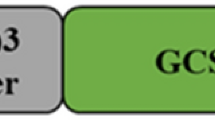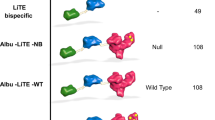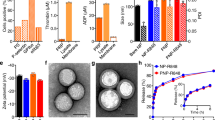Summary:
Fms-like tyrosine kinase (Flt3L) is a potent stimulator of hematopoietic progenitor cell (HPC) expansion and mobilization; however, this requires 7–10 days of administration. We investigated whether sustained delivery of Flt3L using a poloxamer-based matrix (PG) could accelerate and/or improve the hematopoietic activity of Flt3L in mice. A single injection of PG-Flt3L stimulated significantly more rapid and greater HPC mobilization to the spleen and peripheral blood than the daily injection of Flt3L formulated in saline. Pharmacokinetic analysis demonstrated that the formulation of Flt3L in PG prolonged its elimination (Tβ) half-life (2.3-fold) and increased its bioavailability (>two fold) and the time to maximum serum concentration (Tmax) (2.7-fold). Further, coadministration of G-CSF and PG-Flt3L allowed lower doses of Flt3L to be active, with significantly greater hematopoietic and mobilization activity, compared to the same total dose of G-CSF, Flt3L or G-CSF and Flt3L formulated in saline. These data demonstrate that formulation of Flt3L in PG significantly accelerates and increases HPC expansion and mobilization. The observation of increased bioactivity by PG-Flt3L in rodents suggests the potential for improved clinical efficacy of Flt3L by reducing the time required for HPC mobilization.
This is a preview of subscription content, access via your institution
Access options
Subscribe to this journal
Receive 12 print issues and online access
$259.00 per year
only $21.58 per issue
Buy this article
- Purchase on Springer Link
- Instant access to full article PDF
Prices may be subject to local taxes which are calculated during checkout




Similar content being viewed by others
References
Brasel K, McKenna HJ, Morrissey P et al. Hematologic effects of Flt3 ligand in vivo in mice. Blood 1996; 88: 2004–2012.
Robinson S, Mosley RL, Parajuli P et al. Comparison of the hematopoietic activity of Flt-3 ligand and granulocyte–macrophage colony-stimulating factor acting alone or in combination. J Hematother Stem Cell Res 2000; 9: 711–720.
Moghimi SM, Hunter AC . Poloxamers and poloxamines in nanoparticle engineering and experimental medicine. Trends Biotechnol 2000; 18: 412–420.
Morikawa K, Okada F, Hosokawa M, Kobayashi H . Enhancement of therapeutic effects of recombinant interleukin 2 on a transplantable rat fibrosarcoma by the use of a sustained release vehicle, Pluronic Gel. Cancer Res 1987; 47: 37–41.
Johnston TP, Miller SC . Inulin disposition following intramuscular administration of an inulin/Poloxamer gel matrix. J Parenter Sci Technol 1989; 43: 279–286.
Johnston TP, Punjabi MA, Froelich CJ . Sustained delivery of interleukin-2 from a Poloxamer 407 gel matrix following intraperitoneal injection in mice. Pharm Res 1992; 9: 425–434.
Pec EA, Wout ZG, Johnston TP . Biological activity of urease formulated in Poloxamer 407 after intraperitoneal injection in the rat. J Pharm Sci 1992; 81: 626–630.
Lu GW, Jun HW, Dzimianski MT et al. Pharmacokinetic studies of methotrexate in plasma and synovial fluid following i.v. bolus and topical routes of administration in dogs. Pharm Res 1995; 12: 1474–1477.
Paavola A, Yliruusi J, Kajimoto Y et al. Controlled release of lidocaine from injectable gels and efficacy in rat sciatic nerve block. Pharm Res 1995; 12: 1997–2002.
Paavola A, Yliruusi J, Rosenberg P . Controlled release and dura mater permeability of lidocaine and ibuprofen from injectable Poloxamer-based gels. J Control Release 1998; 52: 169–178.
Paavola A, Tarkkila P, Xu M et al. Controlled release gel of ibuprofen and lidocaine in epidural use–analgesia and systemic absorption in pigs. Pharm Res 1998; 15: 482–487.
Veyries ML, Couarraze G, Geiger S et al. Controlled release of vancomycin from Poloxamer 407 gels. Int J Pharm 1999; 192: 183–193.
Barichello JM, Morishita M, Takayama K, Nagai T . Absorption of insuzlin from Pluronic F-127 gels following subcutaneous administration in rats. Int J Pharm 1999; 184:189–198.
Barichello JM, Morishita M, Takayama K et al. Enhanced rectal absorption of insulin-loaded Pluronic F-127 gels containing unsaturated fatty acids. Int J Pharm 1999; 183: 125–132.
Ryu JM, Chung SJ, Lee MH et al. Increased bioavailability of propranolol in rats by retaining thermally gelling liquid suppositories in the rectum. J Control Release 1999; 59: 163–172.
Paavola A, Kilpelainen I, Yliruusi J, Rosenberg P . Controlled release injectable liposomal gel of ibuprofen for epidural analgesia. Int J Pharm 2000; 199: 85–93.
Juhasz J, Lenaerts V, Raymond P, Ong H . Diffusion of rat atrial natriuretic factor in thermoreversible poloxamer gels. Biomaterials 1989; 10: 265–268.
Fults KA, Johnston TP . Sustained-release of urease from a Poloxamer gel matrix. J Parenter Sci Technol 1990; 44: 58–65.
Chi SC, Jun HW . Release rates of ketoprofen from Poloxamer gels in a membraneless diffusion cell. J Pharm Sci 1991; 80: 280–283.
Wang PL, Johnston TP . Enhanced stability of two model proteins in an agitated solution environment using Poloxamer 407. J Parenter Sci Technol 1993; 47: 183–189.
Bhardwaj R, Blanchard J . Controlled-release delivery system for the alpha-MSH analog Melanotan-I using Poloxamer 407. J Pharm Sci 1996; 85: 915–919.
Stratton LP, Dong A, Manning MC, Carpenter JF . Drug delivery matrix containing native protein precipitates suspended in a Poloxamer gel. J Pharm Sci 1997; 86:1006–1010.
Moore T, Croy S, Mallapragada S, Pandit N . Experimental investigation and mathematical modeling of Pluronic F127 gel dissolution: drug release in stirred systems. J Control Release 2000; 67: 191–202.
Anderson BC, Pandit NK, Mallapragada SK . Understanding drug release from poly(ethylene oxide)-b-poly(propylene oxide)-b-poly(ethylene oxide) gels. J Control Release 2001; 70: 157–167.
Desai SD, Blanchard J . Evaluation of Pluronic F127-based sustained-release ocular delivery systems for pilocarpine using the albino rabbit eye model. J Pharm Sci 1998; 87: 1190–1195.
Desai SD, Blanchard J . In vitro evaluation of Pluronic F127-based controlled-release ocular delivery systems for pilocarpine. J Pharm Sci 1998; 87: 226–230.
Brasel K, McKenna HJ, Charrier K et al. Flt3 ligand synergizes with granulocyte–macrophage colony-stimulating factor or granulocyte colony-stimulating factor to mobilize hematopoietic progenitor cells into the peripheral blood of mice. Blood 1997; 90: 3781–3788.
Egger SF, Brown GS, Kelsey LS et al. E. Studies on optimal dose and administration schedule of a hematopoietic stimulatory beta-(14)-linked mannan. Int J Immunopharmacol 1996; 18: 113–126.
Bol S, van den Engh G, Visser J . A technique for staining haemopoietic colonies in agar cultures. Exp Hematol 1977; 5: 551–553.
Katakam M, Banga AK . Use of poloxamer polymers to stabilize recombinant human growth hormone against various processing stresses. Pharm Dev Technol 1997; 2: 43–149.
Illum L, Davis SS . Targeting of colloidal particles to the bone marrow. Life Sci 1987; 40: 1553–1560.
Papayannopoulou T, Nakamoto B, Andrews RG et al. In vivo effects of Flt3/Flk2 ligand on mobilization of hematopoietic progenitors in primates and potent synergistic enhancement with granulocyte colony-stimulating factor. Blood 1997; 90: 620–629.
Molineux G, McCrea C, Yan XQ et al. Flt-3 Ligand synergizes with granulocyte colony-stimulating factor to increase neutrophil numbers and to mobilize peripheral blood stem cells with long-term repopulating potential. Blood 1997; 89: 3998–4004.
Sudo Y, Shimazaki C, Ashihara E et al. Synergistic effect of FLT-3 ligand on the granulocyte colony-stimulating factor-induced mobilization of hematopoietic stem cells and progenitor cells into blood in mice. Blood 1997; 89: 3186–3191.
Pless M, Wodnar-Filipowicz A, John L et al. Synergy of growth factors during mobilization of peripheral blood precursor cells with recombinant human Flt3-ligand and granulocyte colony-stimulating factor in rabbits. Exp Hematol 1999; 27: 155–161.
Schmolka IR . Artificial Skin. I. Preparation and properties of Pluronic F-127 gels for treatment of burns. J Biomed Mater Res 1972; 6: 571–582.
Nalbandian RM, Henry RL, Balko KW et al. Pluronic F-127 gel preparation as an artificial skin in the treatment of third-degree burns in pigs. J Biomed Mater Res 1987; 21: 1135–1148.
Paustian PW, McPherson JC, Haase RR et al. Intravenous Pluronic F-127 in early burn wound treatment in rats. Burns 1993; 19: 187–191.
Pfrimmer W, Joyce RA, Turner AR, Boggs DR . Kinetics of the development of methylcellulose-induced hepatic hematopoiesis in adult mice. Blood 1978; 51: 611–622.
Bernabei PA, Di Lollo S, Saccardi R et al. Endogenous splenic colonies and megakaryopoiesis in methylcellulose treated irradiated mice. Experientia 1985; 41: 97–99.
Stang HD, Boggs DR . Effect of methylcellulose injection on murine hematopoiesis. Am J Physiol 1977; 233: H234–H239.
Johnston E, Crawford J, Blackwell S et al. Randomized, dose-escalation study of SD/01 compared with daily Filgrastim in patients receiving chemotherapy. J Clin Oncol 2000; 18: 2522–2528.
Molineux G, Kinstler O, Briddell B et al. A new form of Filgrastim with sustained duration in vivo and enhanced ability to mobilize PBPC in both mice and humans. Exp Hematol 1999; 27: 1724–1734.
de Haan G, Ausema A, Wilkens M et al. Efficient mobilization of haematopoietic progenitors after a single injection of pegylated recombinant human granulocyte colony-stimulating factor in mouse strains with distinct marrow-cell pool sizes. Br J Haematol 2000; 110: 638–646.
Bowen S, Tare N, Inoue T et al. Relationship between molecular mass and duration of activity of polyethylene glycol conjugated granulocyte colony-stimulating factor mutein. Exp Hematol 1999; 27: 425–432.
Eliason JF, Greway A, Tare N et al. Extended activity in Cynomolgus monkeys of a granulocyte colony- stimulating factor mutein conjugated with high molecular weight polyethylene glycol. Stem Cells 2000; 18: 40–45.
van der Auwera P, Platzer E, Xu ZX et al. Pharmacodynamics and pharmacokinetics of single doses of subcutaneous pegylated human G-CSF mutant (Ro 25-8315) in healthy volunteers: comparison with single and multiple daily doses of Filgrastim. Am J Hematol 2001; 66: 245–251.
Lebsack ME, McKenna HJ, Hoek JA et al. Safety of FLT3 ligand in healthy volunteers. Blood 1997; 90 (Suppl. 1): 170a (abstr. 751).
Acknowledgements
The authors gratefully acknowledge the gift of Flt3L from Immunex Corp. and the assistance of Lisa Chudomelka, Tina Winekauf and Richard Murcek in the preparation of this manuscript. GJR and JMB are employees of RxKinetix, Inc. and JET is a member of the Scientific Advisory Board of RxKinetix, Inc.
Author information
Authors and Affiliations
Rights and permissions
About this article
Cite this article
Robinson, S., Chavez, J., Pisarev, V. et al. Delivery of Flt3 ligand (Flt3L) using a poloxamer-based formulation increases biological activity in mice. Bone Marrow Transplant 31, 361–369 (2003). https://doi.org/10.1038/sj.bmt.1703816
Received:
Accepted:
Published:
Issue Date:
DOI: https://doi.org/10.1038/sj.bmt.1703816
Keywords
This article is cited by
-
FLT3L-induced virtual memory CD8 T cells engage the immune system against tumors
Journal of Biomedical Science (2024)
-
Comparison of the efficacy of hematopoietic stem cell mobilization regimens: a systematic review and network meta-analysis of preclinical studies
Stem Cell Research & Therapy (2021)
-
Gene Therapy-Mediated Reprogramming Tumor Infiltrating T Cells Using IL-2 and Inhibiting NF-κB Signaling Improves the Efficacy of Immunotherapy in a Brain Cancer Model
Neurotherapeutics (2012)



